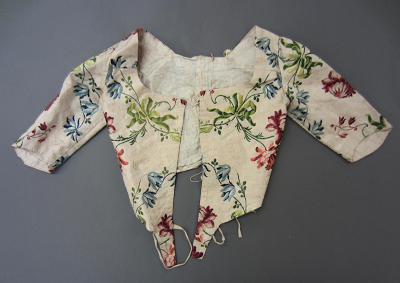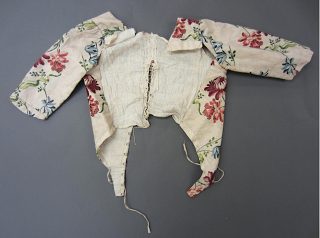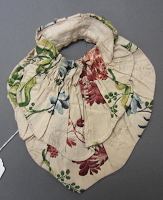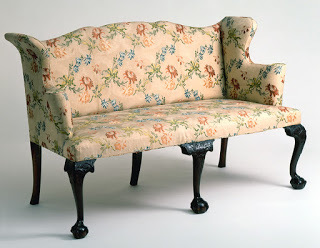The Tragedy of the Ex Dress & the Settee, c1760-80
 Isabella reporting,
Isabella reporting,Fashion never stands still. But as we've discussed here before, women in the past didn't always buy a new dress to reflect a new style, but instead refurbished, retrimmed, or remade existing clothes that they already owned to fit the latest trends. (See examples here , here , here , and here .)
However, that's not what happened to the once-lovely 18thc dress shown here in pieces.
Last week I visited Winterthur Museum for a fine Nerdy History Girls afternoon with Linda Eaton, John & Marjorie P. McGraw Director of Collections and Senior Curator of Textiles. Linda showed me some of the treasures of Winterthur's costume and textiles collection - my idea of a perfect afternoon. In one of the storage rooms, Linda pulled a long archival box from a shelf and asked me if I'd like to see some "ex dresses." This was a new term to me, and at once I envisioned dresses worn by someone's former girlfriend. But in curatorial language, the "ex" refers more to the former state of the textile; in other words, it once was a dress, and now it's a fragment.

When new in 1760-1780, the ex dress shown here was a fashionable robe a la francaise (like this one) , with a floating, pleated back and full petticoat, or skirt. The costly silk was likely woven in either Lyon, France, or Spitalfields, London, England, and imported to colonial America, where it was made up for a wealthy client. The now-unknown mantua-maker who cut and stitched this dress was a skilled seamstress: the meandering floral pattern is carefully matched on the front of the bodice, with the two fronts mirroring one another.

The dress survived intact until the mid-20thc, when it fell prey not to another dressmaker, but to an upholsterer. In a practice common at the time, the dress was cut apart to provide a period-correct fabric for the 18thc settee also in Winterthur's collection, lower right. In theory this was a good choice: the settee was made in New England in 1760-1775, around the same time as the dress, and the style of the robe a la francaise offered plenty of yardage. In the hierarchy of colonial antiques, furniture outranked clothing until the late 20thc (when the study and collecting of historic dress began to be taken more seriously), and so the dress was sacrificed to outfit the settee.
At least the pieces of the dress that couldn't be used were saved - the bodice plus the shaped
 sleeve ruffles, upper right, - but while the fragments are useful for study, they're also heartbreaking. To me the final indignity is the the remnants of the linen lining from the back, above left, showing the inner lacing that would have adjusted the now-vanished pleats.
sleeve ruffles, upper right, - but while the fragments are useful for study, they're also heartbreaking. To me the final indignity is the the remnants of the linen lining from the back, above left, showing the inner lacing that would have adjusted the now-vanished pleats.Many thanks again to Linda Eaton for her assistance with this post.
Left: Ex Dress, maker unknown, silk woven in France or England, dress made in North America, 1760-1780, Winterthur Museum.
Lower right: Settee, maker unknown, Massachusetts, 1760-1775, Winterthur Museum.
Photographs used with permission of Winterthur Museum.
Published on November 27, 2016 17:06
No comments have been added yet.



